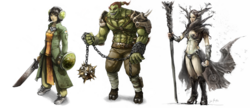
Fantasy films are films that belong to the fantasy genre with fantastic themes, usually magic, supernatural events, mythology, folklore, or exotic fantasy worlds. The genre is considered a form of speculative fiction alongside science fiction films and horror films, although the genres do overlap. Fantasy films often have an element of magic, myth, wonder, escapism, and the extraordinary. Prevalent elements include fairies, mermaids, witches, monsters, wizards, unicorns, dragons, talking animals, ogres, elves, trolls, white magic, gnomes, dwarves, giants, goblins, anthropomorphic or magical objects, familiars, curses and other enchantments, worlds involving magic, and the Middle Ages.

High fantasy, or epic fantasy, is a subgenre of fantasy, defined by the epic nature of its setting or by the epic stature of its characters, themes, or plot. The term "high fantasy" was coined by Lloyd Alexander in a 1971 essay, "High Fantasy and Heroic Romance," which was originally given at the New England Round Table of Children's Librarians in October 1969.
Shelob is a fictional demon in the form of a giant spider from J. R. R. Tolkien's The Lord of the Rings. Her lair lies in Cirith Ungol leading into Mordor. The monstrous Gollum deliberately leads the Hobbit protagonist Frodo there in hopes of recovering the One Ring by letting Shelob attack Frodo. The plan is foiled when Samwise Gamgee temporarily blinds Shelob with the Phial of Galadriel, and then severely wounds her with Frodo's Elvish sword, Sting.

Juvenile fantasy is children's literature with fantasy elements: fantasy intended for readers not yet adult.
Trolls are fictional characters in J. R. R. Tolkien's Middle-earth, and feature in films and games adapted from his novels. They are portrayed as monstrously large humanoids of great strength and poor intellect. In The Hobbit, like the dwarf Alviss of Norse mythology, they must be below ground before dawn or turn to stone, whereas in The Lord of the Rings they are able to face daylight.

Mythopoeia is a narrative genre in modern literature and film where a fictional or artificial mythology is created by the writer of prose or other fiction. This meaning of the word mythopoeia follows its use by J. R. R. Tolkien in the 1930s. The authors in this genre integrate traditional mythological themes and archetypes into fiction.
The works of J. R. R. Tolkien have served as the inspiration to painters, musicians, film-makers and writers, to such an extent that he is sometimes seen as the "father" of the entire genre of high fantasy.
Do not laugh! But once upon a time I had a mind to make a body of more or less connected legend, ranging from the large and cosmogonic to the level of romantic fairy-story... The cycles should be linked to a majestic whole, and yet leave scope for other minds and hands, wielding paint and music and drama. Absurd.

Fantasy tropes are a specific type of literary tropes that occur in fantasy fiction. Worldbuilding, plot, and characterization have many common conventions, many of them ultimately originated with, myth and folklore. J. R. R. Tolkien's legendarium for example, was inspired from a variety of different sources including Germanic, Finnish, Greek, Celtic and Slavic myths. Literary fantasy works operate using these tropes, while others use them in a revisionist manner, making the tropes over for various reasons such as for comic effect, and to create something fresh.

Low fantasy, or intrusion fantasy, is a subgenre of fantasy fiction in which magical events intrude on an otherwise-normal world. The term thus contrasts with high fantasy stories, which take place in fictional worlds that have their own sets of rules and physical laws.

In many works of modern fantasy, elves are depicted as a race or species of pointy-eared humanoid beings. These depictions arise from the álfar of Norse mythology influencing elves in fantasy as being semi-divine and of human stature, whose key traits are being friendly with nature and animals. However, this differs from Norse and the traditional elves found in Middle Ages folklore and Victorian era literature.
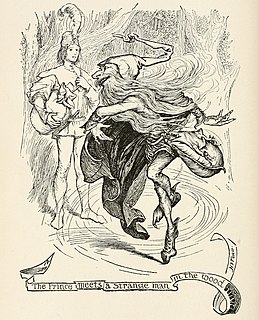
Elements of the supernatural and the fantastic were an element of literature from its beginning. The modern genre is distinguished from tales and folklore which contain fantastic elements, first by the acknowledged fictitious nature of the work, and second by the naming of an author. Works in which the marvels were not necessarily believed, or only half-believed, such as the European romances of chivalry and the tales of the Arabian Nights, slowly evolved into works with such traits. Authors like George MacDonald created the first explicitly fantastic works.
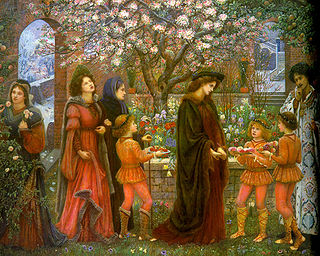
A magician, also known as a mage, warlock, witch, wizard/wizardess, enchanter/enchantress, sorcerer/sorceress or spell caster, is someone who uses or practices magic derived from supernatural, occult, or arcane sources. Magicians are common figures in works of fantasy, such as fantasy literature and role-playing games, and enjoy a rich history in mythology, legends, fiction, and folklore.
The works of J. R. R. Tolkien, especially The Hobbit and The Lord of the Rings, have become extremely popular, and have exerted considerable influence since their publication. A culture of fandom sprang up in the 1960s, leading to many popular votes in favour of the books, but acceptance by the establishment of literary criticism has been slower. Nevertheless, academic studies on Tolkien's works have been appearing at an increasing pace since the mid-1980s, prompting a thorough literary re-evaluation of his work.

In J. R. R. Tolkien's fictional world of Middle-earth, Mordor is the realm and base of the evil Sauron. It lay to the east of Gondor and the great river Anduin, and to the south of Mirkwood. Mount Doom, a volcano in Mordor, was the goal of the Fellowship of the Ring in the quest to destroy the One Ring. Mordor was surrounded by three mountain ranges, to the north, the west, and the south. These both protected the land from invasion and kept those living in Mordor from escaping.
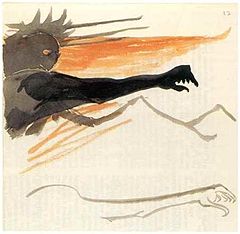
Sauron is the title character and the main antagonist, through the forging of the One Ring, of J. R. R. Tolkien's The Lord of the Rings, where he rules the land of Mordor and has the ambition of ruling the whole of Middle-earth. In the same work, he is identified as the "Necromancer" of Tolkien's earlier novel The Hobbit. In The Silmarillion, he is also described as the chief lieutenant of the first Dark Lord, Morgoth. Tolkien noted that the Ainur, the "angelic" powers of his constructed myth, "were capable of many degrees of error and failing", but by far the worst was "the absolute Satanic rebellion and evil of Morgoth and his satellite Sauron". Sauron appears most often as "the Eye", as if disembodied.
Epic is a genre of narrative defined by heroic or legendary adventures presented in a long format. Originating in the form of epic poetry, the genre also now applies to epic theatre, epic films, music, novels, stage play, television series, and video games. Scholars argue that 'the epic' has long since become "disembedded" from its origins in oral poetry.
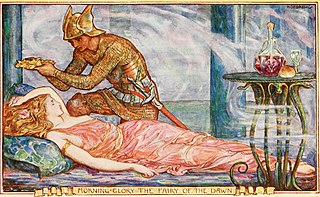
Fantasy is a genre of speculative fiction set in a fictional universe, often inspired by real world myth and folklore. Its roots are in oral traditions, which then became fantasy literature and drama. From the twentieth century it has expanded further into various media, including film, television, graphic novels, manga, animated movies and video games.

The following outline is provided as an overview of and topical guide to fantasy:
Character pairing in The Lord of the Rings is a literary device used by J. R. R. Tolkien, a Roman Catholic, to express some of the moral complexity of his major characters in his heroic romance, The Lord of the Rings. Commentators have noted that the format of a fantasy does not lend itself to subtlety of characterisation, but that pairing allows inner tensions to be expressed as linked opposites, including, in a psychoanalytic interpretation, those of Jungian archetypes.

